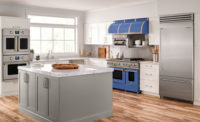Whirlpool’s assembly lines have produced a diverse array of products that aren't found in kitchens or laundry rooms, such as air rifles, toys, threshing machines, lawnmowers and automobiles.
Whirlpool’s assembly lines have mass-produced millions of washing machines, dishwashers, refrigerators and other household appliances over the last 100 years. But, the company has also made a diverse array of products that are not typically found in kitchens or laundry rooms, such as air rifles, tinplate toys, threshing machines, lawnmowers and automobiles.
Before Maytag Co. started to build washing machines in 1907, the company was a leading manufacturer of farm implements (company founder, Frederick Maytag, was a former farmer who built washers as a way to fill seasonal slumps in production). It specialized in threshing machines, but also built hay presses, corn huskers, shredders, band cutters, self-feeders and other harvesting devices. Maytag abandoned the farm equipment business in the early 1920s when it became the top-selling washing machine manufacturer.
Maytag was also associated with the fledgling auto industry for a brief period of time. In 1909, Fred Maytag bought a controlling interest in the Mason Automobile Co. of Des Moines. He changed its name to Maytag-Mason Automobile Co. and moved its plant to Waterloo, IA.
The 2-cylinder, chain-driven Maytag automobile featured a horizontally opposed engine and was famous for its hill-climbing ability. Maytag introduced a gear drive mechanism and a 4-cylinder engine, in addition to a line of small delivery trucks.
Despite the involvement of engineers Fred and August Duesenberg, who eventually went on to build their own luxurious automobiles in Indiana during the 1920s, Maytag lost a considerable investment in the venture and pulled out. The company’s name was changed back to Mason Motor Co. in 1912.
Three years after the Upton Machine Co. first started building electric washing machines in 1911, a company across the street from its factory on Edgewater Dr. in St. Joseph, MI, experienced serious financial difficulties. American Tool Works manufactured a line of air rifles and popguns. Lou and Emory Upton acquired the business and made some minor improvements to the air rifle design.
During the next 10 years, the guns kept the small Upton Machine Co. in business. At the time, electric washing machines were difficult to sell, because they were considered to be a luxury item. The company also didn’t have the resources to promote the sale of its washers in sufficient volume to maintain its solvency with that product alone.
Soon after the acquisition of the air rifle line, the Uptons developed a line of small toys that were sold in chain stores such as Woolworths. In fact, Upton Machine Co. dabbled in the auto industry when it mass-produced tinplate toy cars and trucks. For instance, when Ford Motor Co. unveiled its Model A in 1927, Upton produced a 7-inch long model that was distributed as a promotional item.
The toys were inexpensively manufactured from folded lightweight tin using tab and slot construction. No soldering was used, which sped up assembly. The toy cars sold for 10 cents apiece. Today, a few still exist and they are highly collectable (many are worth up to $500).
Upton Machine Co. also developed a line of metal camping kits. The Kamp Kook Kit was marketed as “a neat compact outdoor cooking outfit consisting of two frying pans, two cups, a stewing kettle and a grid.” A companion product called the Upton Scout Mess Kit ($2.25 suggested retail price) was a smaller version of the Kamp Kook Kit ($3.50).
An ad in the November 1919 issue ofBoys’ Lifemagazine urged kids to “Come Out in the Woods! Come out where you can tramp, hike and explore-out in the open where you can enjoy cooking your meals over a camp fire, where you can hunt, or shoot at targets, with an Upton Air Rifle . . . The Upton has a reputation for accuracy and penetrating force. Made with walnut finish stock and army blue steel type of barrel . . . Enjoy the fun and sport which an Upton Air Rifle and Kamp Kook Kit will give.”
The air rifle, camping and toy businesses were sold in 1926 so that Upton could concentrate on building washing machines (after it began supplying Sears, Roebuck & Co. a few years earlier, production volume increased dramatically).
Maytag built a line of gas-powered toy race cars between 1934 and 1941. They were powered by the Maytag Multi-Motor, which was used in washing machines. The Maytag Toy Racers were distributed to appliance dealers for promotional purposes. Many were used in local parades and some found their way into carnival rides. Maytag also adapted its Multi-Motor for use with cream separators, electric generators and lawnmowers.
During World War II, Maytag and Upton (by now known as the Nineteen Hundred Corp. after a merger in1929) ceased manufacturing washers. Factories were modified to produce components for the P-40 Warhawk aircraft and other military vehicles. More than 2 million pounds of war materials were produced, including anti-aircraft guns, aircraft propeller pitch controls, trailing edges for fighter wings, hydraulic steering mechanisms for tank retrievers, carburetor parts, pumps, gears and gear case
Maytag made parts for 16 different combat planes, including the B-17 Flying Fortress, the B-29 Super Fortress, the B-26 Marauder and the P-51 Mustang. The company’s engineers simplified a wide variety of complex mechanisms to improve performance and quality. For example, a bomb bay actuating cylinder was reduced from 110 components to only 28 parts. This cut cost and lowered production time.
During the 1960s, Whirlpool engineers developed some out-of-this-world products. In October 1960, the company received a government contract to design and build America’s first experimental space kitchen. The kitchen included a miniature thermoelectric refrigerator, freezer, three-cavity oven, self-heated water system, storage space for food, and disposal units for both dry and wet waste.
This was the first attempt by appliance engineers to cope with the problems of zero gravity, and a number of innovative solutions were developed. Whirlpool continued working with NASA to develop food and equipment for space travel, pioneering the development of food, waste management and personal hygiene systems used in all of theGemini,ApolloandSkylabmissions.
Everything But the Kitchen Sink

Looking for a reprint of this article?
From high-res PDFs to custom plaques, order your copy today!






